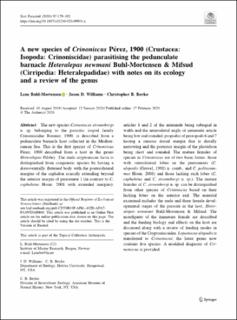| dc.contributor.author | Buhl-Mortensen, Lene | |
| dc.contributor.author | Williams, Jason D. | |
| dc.contributor.author | Boyko, Christopher B | |
| dc.date.accessioned | 2020-10-21T13:03:58Z | |
| dc.date.available | 2020-10-21T13:03:58Z | |
| dc.date.created | 2020-04-23T17:44:03Z | |
| dc.date.issued | 2020 | |
| dc.identifier.citation | Systematic Parasitology. 2020, 97 (2), 179-192. | en_US |
| dc.identifier.issn | 0165-5752 | |
| dc.identifier.uri | https://hdl.handle.net/11250/2684238 | |
| dc.description.abstract | The new species Crinoniscus stroembergi n. sp. belonging to the parasitic isopod family Crinoniscidae Bonnier, 1900, is described from a pedunculate barnacle host collected in the Mediterranean Sea. This is the first species of Crinoniscus Pérez, 1900 described from a host in the genus Heteralepas Pilsbry. The male cryptoniscus larva is distinguished from congeneric species by having a dorsoventrally flattened body with the posterolateral margins of the cephalon scarcely extending beyond the anterior margin of pereomere 1 (in contrast to C. cephalatus Hosie, 2008 with extended margins); articles 1 and 2 of the antennule being subequal in width and the anterodistal angle of antennule article being low and rounded; propodus of pereopods 6 and 7 having a sinuous dorsal margin that is distally narrowing and the posterior margin of the pleotelson being short and rounded. The mature females of species in Crinoniscus are of two basic forms: those with ventrolateral lobes on the pereomeres (C. alepadis (Gruvel, 1901) n. comb., and C. politosummus Hosie, 2008) and those lacking such lobes (C. cephalatus and C. stroembergi n. sp.). The mature females of C. stroembergi n. sp. can be distinguished from other species of Crininiscus based on their lacking lobes on the anterior end. The material examined includes the male and three female developmental stages of the parasite in the host, Heteralepas newmani Buhl-Mortensen & Mifsud. The mouthparts of the immature female are described and the feeding biology and effects on the host are discussed along with a review of feeding modes in species of the Cryptoniscoidea. Leponiscus alepadis is transferred to Crinoniscus; the latter genus now contains five species. A modified diagnosis of Crinoniscus is provided. | en_US |
| dc.language.iso | eng | en_US |
| dc.title | A new species of Crinoniscus Pérez, 1900 (Crustacea: Isopoda: Crinoniscidae) parasitising the pedunculate barnacle Heteralepas newmani Buhl-Mortensen & Mifsud (Cirripedia: Heteralepadidae) with notes on its ecology and a review of the genus | en_US |
| dc.type | Peer reviewed | en_US |
| dc.type | Journal article | en_US |
| dc.description.version | publishedVersion | en_US |
| dc.source.pagenumber | 179-192 | en_US |
| dc.source.volume | 97 | en_US |
| dc.source.journal | Systematic Parasitology | en_US |
| dc.source.issue | 2 | en_US |
| dc.identifier.doi | 10.1007/s11230-020-09903-x | |
| dc.identifier.cristin | 1807749 | |
| cristin.ispublished | true | |
| cristin.fulltext | original | |
| cristin.qualitycode | 1 | |
